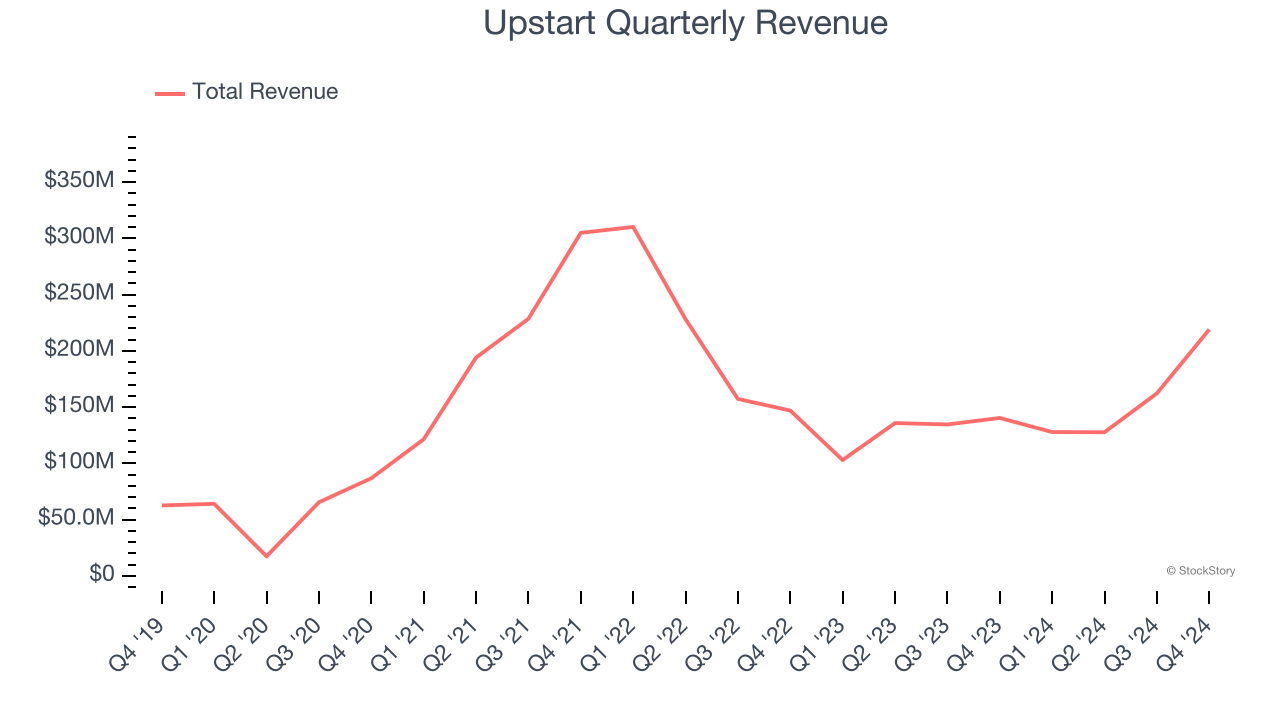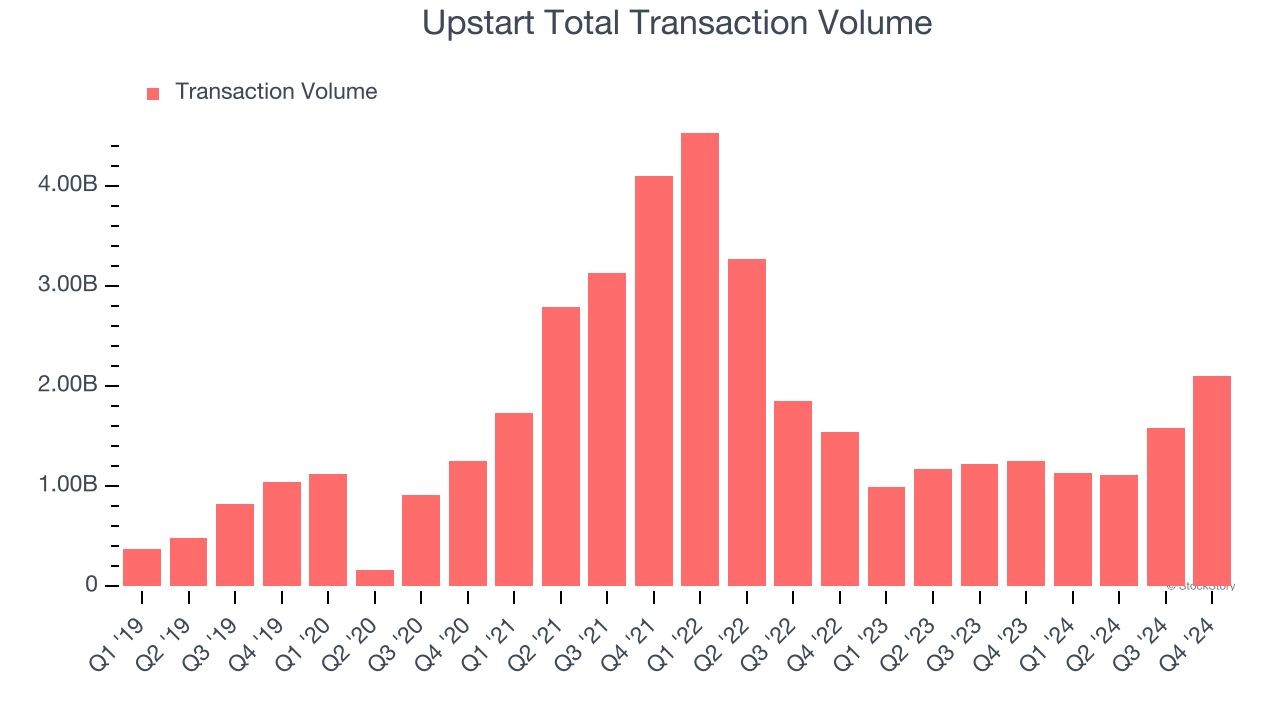
AI-powered lending platform Upstart (NASDAQ: UPST) reported Q4 CY2024 results topping the market’s revenue expectations, with sales up 56.1% year on year to $219 million. On top of that, next quarter’s revenue guidance ($200 million at the midpoint) was surprisingly good and 10.8% above what analysts were expecting. Its non-GAAP profit of $0.26 per share was significantly above analysts’ consensus estimates.
Is now the time to buy Upstart? Find out by accessing our full research report, it’s free.
Upstart (UPST) Q4 CY2024 Highlights:
- Revenue: $219 million vs analyst estimates of $182.4 million (56.1% year-on-year growth, 20.1% beat)
- Adjusted EPS: $0.26 vs analyst estimates of -$0.04 (significant beat)
- Adjusted Operating Income: $121.9 million vs analyst estimates of -$35.49 million (55.7% margin, significant beat)
- Management’s revenue guidance for the upcoming financial year 2025 is $1 billion at the midpoint, beating analyst estimates by 21.5% and implying 57.1% growth (vs 23.7% in FY2024)
- EBITDA guidance for Q1 CY2025 is $27 million at the midpoint, above analyst estimates of $9.53 million
- Operating Margin: -2.2%, up from -33.9% in the same quarter last year
- Free Cash Flow was -$114.3 million, down from $158.1 million in the previous quarter
- Market Capitalization: $6.47 billion
“In Q4 of 2024, our business grew dramatically across all product categories, delivered Adjusted EBITDA at levels not seen since the first quarter of 2022, and came within a whisker of returning to GAAP profitability,” said Dave Girouard, co-founder and CEO of Upstart.
Company Overview
Founded by the former head of Google's enterprise business, Upstart (NASDAQ: UPST) is an AI-powered lending platform facilitating loans for banks and consumers.
Lending Software
Businesses have come to use data driven insights to stratify their customers into more granular buckets that enable more personalized (and profitable) offerings. Lending software is a prime example of fintech democratizing access to loans in a still-profitable manner for financial institutions.
Sales Growth
Reviewing a company’s long-term sales performance reveals insights into its quality. Any business can have short-term success, but a top-tier one grows for years. Upstart’s demand was weak over the last three years as its sales fell at a 9.1% annual rate. This fell short of our benchmarks, but there are still things to like about Upstart.

This quarter, Upstart reported magnificent year-on-year revenue growth of 56.1%, and its $219 million of revenue beat Wall Street’s estimates by 20.1%. Company management is currently guiding for a 56.5% year-on-year increase in sales next quarter.
Looking further ahead, sell-side analysts expect revenue to grow 30.1% over the next 12 months, an acceleration versus the last three years. This projection is eye-popping and suggests its newer products and services will fuel better top-line performance.
Software is eating the world and there is virtually no industry left that has been untouched by it. That drives increasing demand for tools helping software developers do their jobs, whether it be monitoring critical cloud infrastructure, integrating audio and video functionality, or ensuring smooth content streaming. Click here to access a free report on our 3 favorite stocks to play this generational megatrend.
Total Transaction Volume
Total transaction volumes show the aggregate dollar value of loans processed on Upstart’s platform. This is the number from which the company will ultimately collect fees, and the higher it is, the more accurate its software becomes at assessing credit risk.
Upstart’s transaction volume punched in at $2.11 billion in Q4, and over the last four quarters, its growth was fantastic as it averaged 26.4% year-on-year increases. This alternate topline metric grew faster than total sales, meaning its loan processing fees outpaced the interest income from loans retained on its balance sheet. If this trend continues, it would lower Upstart’s risk profile as it would reduce its exposure to delinquencies and defaults. 
Customer Acquisition Efficiency
The customer acquisition cost (CAC) payback period represents the months required to recover the cost of acquiring a new customer. Essentially, it’s the break-even point for sales and marketing investments. A shorter CAC payback period is ideal, as it implies better returns on investment and business scalability.
Upstart’s recent customer acquisition efforts haven’t yielded returns as its CAC payback period was negative this quarter, meaning its incremental sales and marketing investments outpaced its revenue. The company’s inefficiency indicates it operates in a competitive market and must continue investing to grow.
Key Takeaways from Upstart’s Q4 Results
This was an insanely good quarter from Upstart. For starters, it demolished analysts' revenue, EPS, and adjusted operating income expectations. On top of that, its revenue and EBITDA guidance for next quarter beat Wall Street’s estimates by a huge margin. No surprise the stock traded up 23.7% to $83.31 immediately following the results.
Upstart put up rock-solid earnings, but one quarter doesn’t necessarily make the stock a buy. Let’s see if this is a good investment. We think that the latest quarter is only one piece of the longer-term business quality puzzle. Quality, when combined with valuation, can help determine if the stock is a buy. We cover that in our actionable full research report which you can read here, it’s free.





